
The Stadttempel (English: City Prayer House), also called the Seitenstettengasse Temple, is the main synagogue of Vienna, Austria. It is located in the Innere Stadt 1st district, at Seitenstettengasse 4.

The Stadttempel (English: City Prayer House), also called the Seitenstettengasse Temple, is the main synagogue of Vienna, Austria. It is located in the Innere Stadt 1st district, at Seitenstettengasse 4.
The synagogue was constructed from 1824 to 1826. The luxurious Stadttempel was fitted into a block of houses and hidden from plain view of the street, because of an edict issued by Emperor Joseph II that only Roman Catholic places of worship were allowed to be built with facades fronting directly on to public streets.
This edict saved the synagogue from total destruction during the Kristallnacht in November 1938, since the synagogue could not be destroyed without setting on fire the buildings to which it was attached. The Stadttempel was the only synagogue in the city to survive World War II, as Nazi paramilitary troops with the help of local authorities destroyed all of the other 93 synagogues and Jewish prayer-houses in Vienna, starting with the Kristallnacht. [1] [2]
In August 1950, the coffins of Theodor Herzl and his parents were displayed at the synagogue, prior to their transfer for reburial in Israel. [3] [4]
In the 1981 Vienna synagogue attack, two people from a bar mitzvah ceremony at the synagogue were murdered and thirty injured when Palestinian Arab terrorists attacked the synagogue with machine guns and hand grenades. [5]
Today the synagogue is the main house of prayer for the Viennese Jewish Community of about 7,000 members. [3]
The synagogue has been declared a historic monument. [3] [6]
On 2 November 2020, a terrorist attack near the synagogue left four civilians dead and 23 others wounded. It was not immediately certain if the synagogue was the target of the attack. [7] [8] [9]

The synagogue was designed in elegant Biedermeier style by the Viennese architect Joseph Kornhäusel, architect to Johann I Joseph, Prince of Liechtenstein, for whom he had built palaces, theaters and other buildings. Construction was supervised by the official municipal architect, Jacob Heinz. [6]
Two five-story apartment houses, Numbers 2 and 4 Seitenstettengasse, were built at the same time as the synagogue, designed by the architect to screen the synagogue from the street in compliance with the Patent of Toleration, which permitted members of tolerated faiths to worship in clandestine churches, but not in buildings with facades on public streets. [10] The synagogue is structurally attached to the apartment building at # 4 Seitenstettengasse. [6]

The synagogue itself is in the form of an oval. A ring of twelve Ionic columns support a two-tiered women's gallery. Originally, the galleries ended one column away from the Torah Ark, they were later extended to the columns beside the ark to provide more seating. the building is domed and lit by a lantern in the center of the dome, in classic Biedermeyer style. [6]
A commemorative glass made at the time of the synagogue's dedication and etched with a detailed image of the synagogue's interior is now in the collection of the Jewish Museum (New York). [11]
The synagogue underwent renovation in 1895 and again in 1904 by the Jewish architect Wilhelm Stiassny, adding considerable ornamentation, and, in the opinion of architectural historian Rachel Wischnitzer, "the serene harmony of the design was spoiled by renovations." [3] [6] Damage inflicted on Kristallnacht was repaired in 1949. The "Stadttempel" was renovated once again in 1963 by Prof. Otto Niedermoser. [3]

Synagogue architecture often follows styles in vogue at the place and time of construction. There is no set blueprint for synagogues and the architectural shapes and interior designs of synagogues vary greatly. According to tradition, the Shekhinah or divine presence can be found wherever there is a minyan, a quorum, of ten. A synagogue always contains an Torah ark where the Torah scrolls are kept, called the aron qodesh by Ashkenazi Jews and the hekhal by Sephardic Jews.

Judenplatz is a town square in Vienna's Innere Stadt that was the center of Jewish life and the Viennese Jewish Community in the Middle Ages. It is located in the immediate proximity of Am Hof square, Schulhof, and Wipplingerstraße. It exemplifies the long and eventful history of the city and the Jewish community focused on this place. Archaeological excavations of the medieval synagogue are viewable underground by way of the museum on the square, Misrachi-Haus. Two sculptural works, a carved relief and several inscribed texts are located around the square that all have subject matter relating to Jewish history. One of these sculptures is a statue of Gotthold Ephraim Lessing. The other is a memorial to Austrian Holocaust Victims, a project based on an idea of Simon Wiesenthal and unveiled in 2000. Created by British artist Rachel Whiteread, the memorial is a reinforced concrete cube resembling a library with its volumes turned inside out.
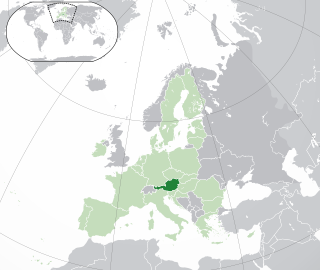
The history of the Jews in Austria probably begins with the exodus of Jews from Judea under Roman occupation. There have been Jews in Austria since the 3rd century CE. Over the course of many centuries, the political status of the community rose and fell many times: during certain periods, the Jewish community prospered and enjoyed political equality, and during other periods it suffered pogroms, deportations to concentration camps and mass murder, and antisemitism. The Holocaust drastically reduced the Jewish community in Austria and only 8,140 Jews remained in Austria according to the 2001 census. Today, Austria has a Jewish population of 10,300 which extends to 33,000 if Law of Return is accounted for, meaning having at least one Jewish grandparent.

The Leopoldstädter Tempel was the largest synagogue of Vienna, in the district (Bezirk) of Leopoldstadt. It was also known as the Israelitische Bethaus in der Wiener Vorstadt Leopoldstadt. It was built in 1858 in a Moorish Revival style by the architect Ludwig Förster. The tripartite facade of the Leopoldstädter, with its tall central section flanked by lower wings on each side, became the model for numerous Moorish Revival synagogues, including the Choral Temple in Bucharest, which has an almost identical main facade, the Zagreb Synagogue, the Spanish Synagogue in Prague, the Tempel Synagogue in Kraków and the Grand Synagogue of Edirne.
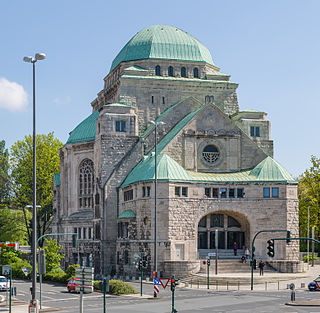
The Old Synagogue in Essen is one of the largest, best preserved and architecturally most impressive testimonies to Jewish culture in pre-war Germany. Built in the centre of the city, the Byzantine style former Synagogue was originally consecrated as the Neue Synagoge in 1913; it now houses an institution dedicated to documenting and promoting the history of the city's former Jewish community.

Isaac Noah Mannheimer was a rabbi and member of the House of Deputies.

Ludwig Christian Friedrich (von) Förster was a German-born Austrian architect. While he was not Jewish, he is known for building Jewish synagogues and churches.

The Great Synagogue of London was, for centuries, the centre of Ashkenazi synagogue and Jewish life in London. Built north of Aldgate in the 17th century, it was destroyed during World War II, in the Blitz.

The Dohány Street Synagogue, also known as the Great Synagogue or Tabakgasse Synagogue, is a historical building on Dohány Street in Erzsébetváros, the 7th district of Budapest, Hungary. It is the largest synagogue in Europe, seating 3,000 people and is a centre of Neolog Judaism.
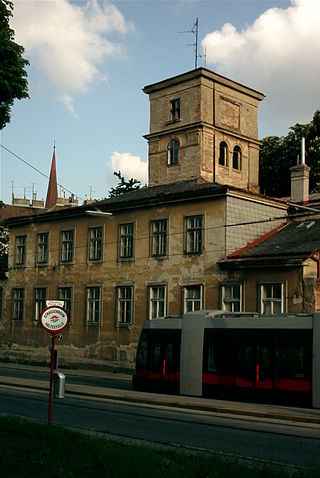
Josef Georg Kornhäusel was an Austrian architect of the first half of the 19th century. He primarily employed the contemporary style of Neoclassical architecture, moving to the Biedermeier style in his later oevre.
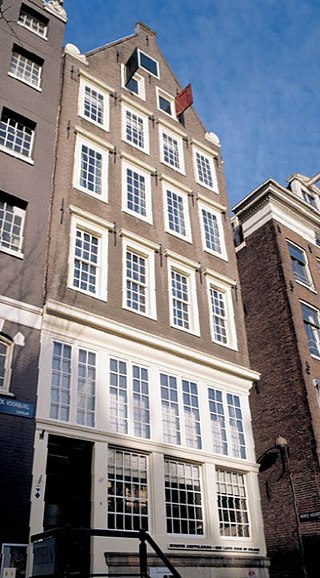
A clandestine church, defined by historian Benjamin J. Kaplan as a "semi-clandestine church", is a house of worship used by religious minorities whose communal worship is tolerated by those of the majority faith on condition that it is discreet and not conducted in public spaces. Schuilkerken are commonly built inside houses or other buildings, and do not show a public façade to the street. They were an important advance in religious tolerance in the wake of the Reformation, an era when worship services conducted by minority faiths were often banned and sometimes penalized by exile or execution.
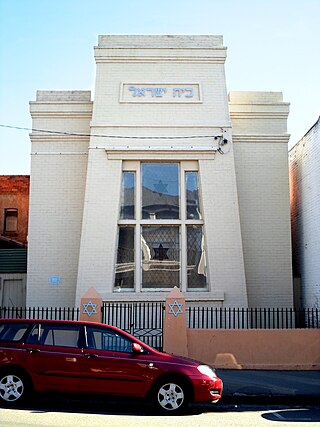
The Launceston Synagogue is a heritage-listed building located in St. John's Street, Launceston, Tasmania, Australia, that served as a synagogue from 1846 until 1871, and again during the c. 1930s until its closure in 1961 and reopened in 1984.
The 1981 Vienna synagogue attack was a terror attack that occurred 29 August 1981. The incident took place in the Stadttempel of Vienna, Austria carried out by two terrorists of the Abu Nidal Organization.
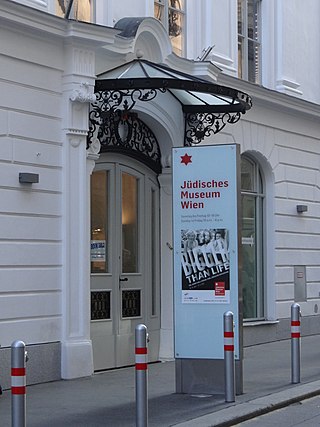
The Jüdisches Museum Wien, trading as Jüdisches Museum der Stadt Wien GmbH or the Jewish Museum Vienna, is a museum of Jewish history, life and religion in Austria. The museum is present on two locations, in the Palais Eskeles in the Dorotheergasse and in the Judenplatz, and has distinguished itself by a very active programme of exhibitions and outreach events highlighting the past and present of Jewish culture in Austria. The current director is Barbara Staudinger and the chief curator is Astrid Peterle.
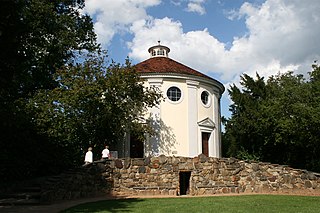
The Wörlitz Synagogue is a synagogue built in 1790 by order of Duke Leopold III of Anhalt-Dessau. It is located within the Dessau-Wörlitz Garden Realm, a UNESCO World Heritage Site since 2000.
The history of the Jews in Vienna, Austria, goes back over eight hundred years. There is evidence of a Jewish presence in Vienna from the 12th century onwards.

The Jewish Community of Vienna is the body that represents Vienna's Orthodox Jewish community. Today, the IKG has around 10 000 members. Throughout history, it has represented almost all of Austria's Jews, whose numbers are sufficient to form communities in only a few other cities in Austria.

The Kassel Synagogue is the description given to a succession of prayer houses of the Jewish community in Kassel, Hesse.
The 2020 Vienna attack was a series of shootings that occurred on 2 November 2020 in Vienna, Austria. A few hours before the city was to enter a lockdown due to the COVID-19 pandemic, a lone gunman started shooting in the busy city centre. Four civilians were killed in the attack and 23 others were injured, seven critically, including a police officer. The attacker was killed by police and was later identified as an ISIL sympathizer. Officials said that the attack was an incident of Islamist terrorism.
The Holocaust in Austria was the systematic persecution, plunder and extermination of Jews by German and Austrian Nazis from 1938 to 1945. An estimated 65,000 Jews were murdered and 125,000 forced to flee Austria as refugees.
{{cite news}}: CS1 maint: multiple names: authors list (link)